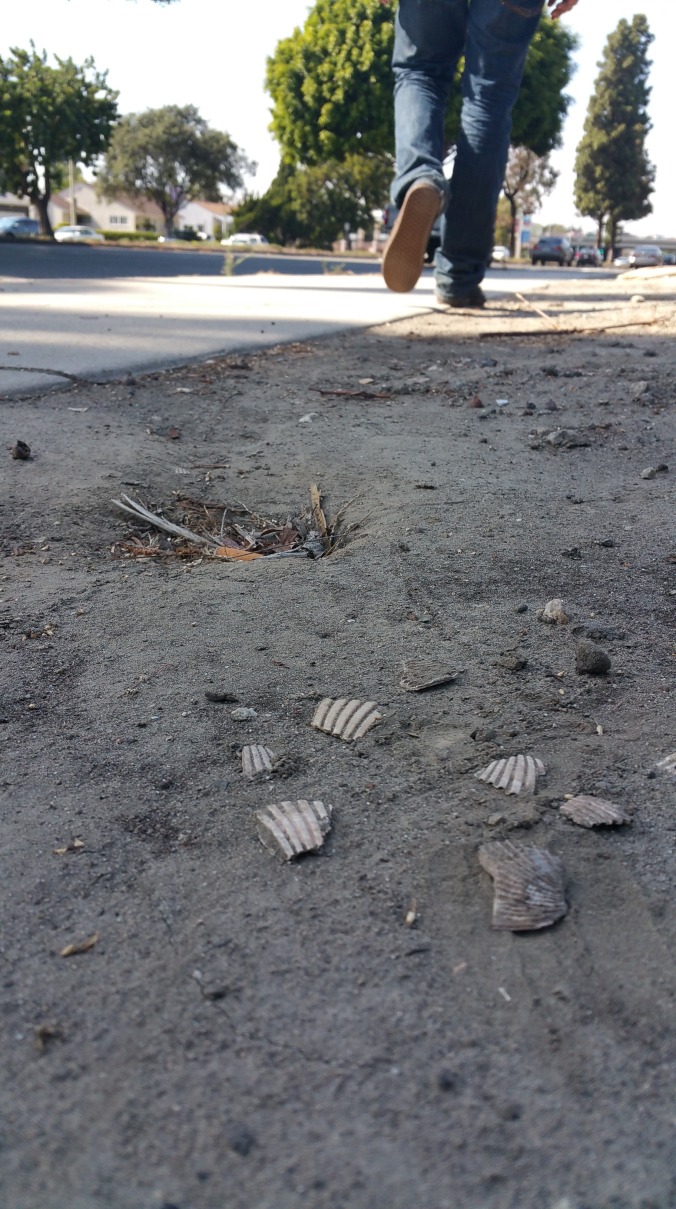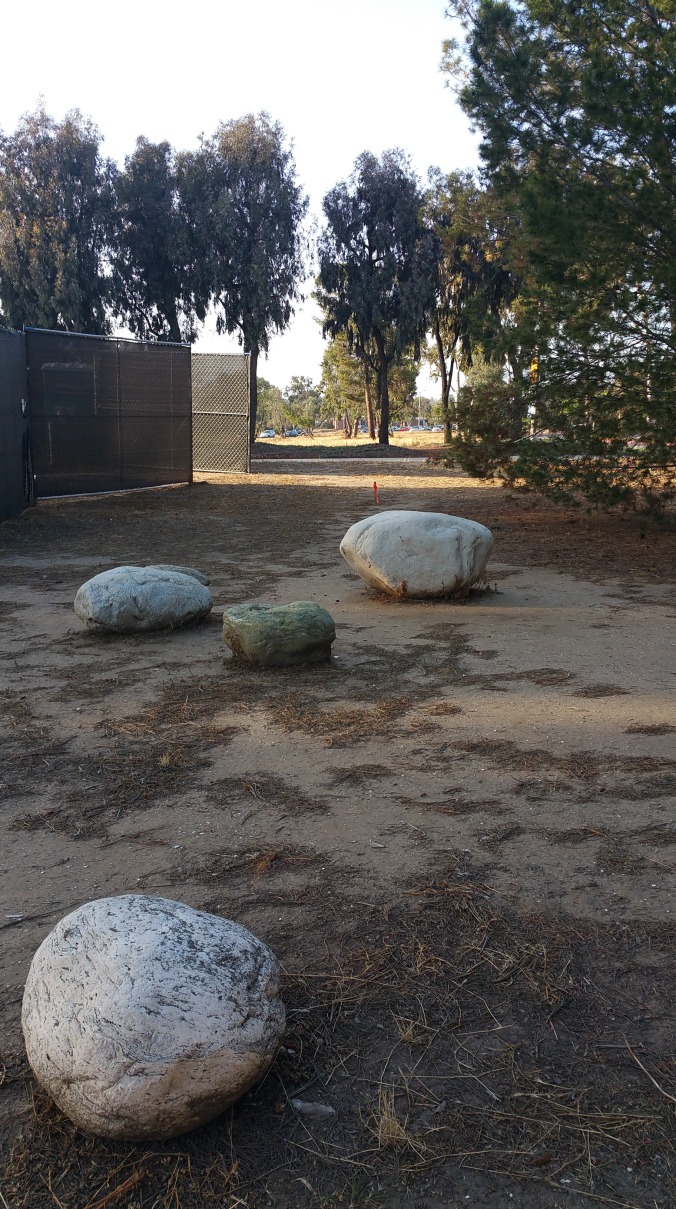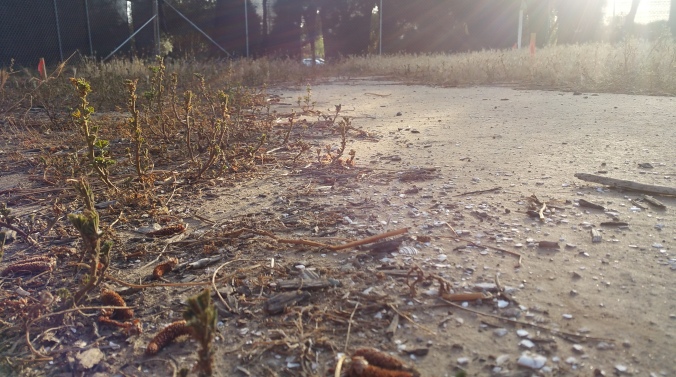At the intersection of the 405 and Bellflower Blvd. in Long Beach, brittle fragments of white shell scatter the ground where water has not run for a century. These shellfish deposits give archaeologists an insight to late period people’s’ lifestyles, subsistence and the landscape they navigated.

It’s easy to bypass the seashells that sit at the intersection of Bellflower Blvd. and the 405 freeway in Long Beach, where over 60 years ago archaeologists uncovered the remains of 21 individuals.
It is there, between suburban sidewalks and a major freeway, that a CSULB archaeologist and her team of students uncovered the remains of 21 individuals in 1952. Their skeletons were buried in flexed positions, oriented from the East to West and surrounded by ornamental beads, tools and pottery shards.
Construction workers found the first body while working on 1950s housing development in what is today the Los Altos neighborhood and appropriately called in the anthropologists from the four-year young Cal State College, Long Beach just a mile away.
According to the National Park Service release of inventory completion, CSCLB archaeologist Ethel E. Ewing led a field school to remove the human remains from the site, known as Los Angeles County site 270 (CA-LAn-270). These remains were taken to the CSCLB archaeology lab and for almost five decades they have been stored in a supply closet in the Liberal Arts 5 building.
This spring, a team of students led by another archaeology professor has been working to reverse the damage by putting those individuals back to rest.
Halfway through the 20th century, a man named Whaley constructed the residential Los Altos as we know it today, including the commercial center near the quickly expanding CSCLB campus. Last year the Long Beach Press-Telegram praised Whaley for transforming that part of East Long Beach into the suburban paradise it is today:
“Lloyd Whaley could see past the farmland and marshes that stretched east of Bellflower Boulevard to develop what is now much of Long Beach’s modern suburbia.”
A century earlier, during the rancho period, the land was split up around the pueblo of Los Angeles. Spanish soldier Manuel Nieto received the wide expanse of Los Alamitos, which was eventually divvied up between his successors. Some of the land housed missions at the time of Mexico’s independence from Spain in 1821. The landscape continued to change with conquer and colonization, ripped and torn by the 1848 Gold Rush.
Those homes of Los Altos residents, formerly ranches and Mexican territory, were layers above the land on which the sedentary Tongva people lived, subsisted and were ceremonially buried 1500 to 500 years ago. In that time, the land was owned by nobody. The river flooded and receded, and the people moved back and forth between the San Gabriel Mountains and the waters. They gathered acorns and other plants, thrived off of shellfish, made pottery and jewelry and traded with populations to the South. They had a concentrated burial area.
Tongva means “people of the earth.” Spanish settlers renamed the group Gabrielino, to prescribe to the trend of naming tribes after missions. The name stuck for some, but the group prefers to be known as the Gabrielino-Tongva. According to the tribe’s website, many ancient villages were centered on the Los Angeles, San Gabriel and Santa Ana rivers. In Los Angeles County alone, there are over 100 sites associated with the Gabrielino-Tongva.
Alvitre calls these different stages of Long Beach “cultural layers,” and the Gabrielino-Tongva of the modern metropolis that is Southern California have made sure to hold onto a piece of theirs.
“As we go back in time you have to deconstruct this whole colonial process, you know…we have to deconstruct the university, we have to deconstruct the agricultural processes that were here,” Cindi Alvitre, CSULB professor of American Indian Studies, said.
Carl Lipo’s Spring 2015 Anthropology 450 class meets for six hours twice a week in a room filled with digging and measurement tools. The class sits at a large rectangular table speckled with chunks of dirt, microscopes and boxes of tools.
On Lipo’s board are scribbled trigonometric equations; his desk was messy and scattered with circuits and broken electronics. The CSULB archaeology professor has done landmark research on the walking Easter Island heads and now, he’s putting history back into the earth.
The CA-LAn-270 remains of the 21 individuals uncovered in 1952 are still stored in a few boxes in a dark closet of the Liberal Arts 5 building. They were placed there by a small group of scholars about six decades ago, and the very similar group of archaeology students in Lipo’s class will return them to the earth on the CSULB campus, at the site on the South side of Beach drive called CA-LAn-234.
But the remains cannot be returned as easily as they were removed 60 years ago.
“Were waiting from the state historic preservation office to proceed to make sure that the space that we want to physically do the reburial is clear, that when we go in there were not disturbing anything of significance that there’s not any other archeological material or cultural resources,” Alvitre said.

The site of reburial sits on land where, in 1979, archaeologists reburied remains of a partial body found across the street. The reburial of the 21 individuals is delayed until further approval from the state’s Historic Preservation office.
Lipo hasn’t explicitly mentioned to the class that the remains may already exist on the site of reburial—but they’re following proper excavation procedures nonetheless.
A partial body was found in 1972 during a dig for a sprinkler line on what is now a site designated as CA-LAn-235—more well-known as Puvungna, Gabrielino-Tongva land recognized in the National Register of Historic Places that to the passerby seems to be an empty space next to the CSULB Japanese Garden. The remains were reburied 7 years later at the current site of the re-interment, across Beach drive.
Lipo said the goal is not to find anything whatsoever, and he is most concerned about remains that exist at the surface. He said that this pit could be anywhere on the CA-LAn-234 site, now demarcated by a tall black enclosure that may continue to stand through summer and into the fall semester.
“Any information that we can get about the subsurface is useful,” Lipo said.
As of a month ago, the class was cleared to only 10 centimeters of their 3-meter goal. The site is still untouched save for wooden markers.

Though students had been cleared to dig 10 centimeters as of a month ago, the land is still untouched. Lipo is recruiting students for a field school during the Summer 2015 session to continue the project.
While they wait for federal approval, the class has been learning about Cultural Resource Management, scanning with Ground Penetrating Radar (GPR), conductivity, resistance and magnotometry to make sure no archaeological material—which includes human remains, artifacts and objects of historical significance— in the subsurface will be disturbed.
“Excavation is destructive,” Candice Brennan, a graduate student of anthropology and a student of Lipo’s, said.
Though it’s not as exhilarating as the work of fabled archaeologists like Indiana Jones, Brennan is conducting research on the settlement patterns of the population that the remains represent, analyzing all documented sites, of which there are over a dozen, West of Alamitos bay. She has been using U.S. Geological Survey maps to build a chronology of how the people moved from the fish-rich marshlands to the high areas when the lands flooded.
Because there are so many potential sites and thus potential burials, both Alvitre and Lipo agree that the underground is rich with cultural history that should remain untouched.
“It’s the unknown [remains] we are worried about,” Lipo said.
Archaeologists have come to worry much more about burial and artifact sensitivity since the Native American Graves Protection and Repatriation Act was passed in 1990. Lipo serves as the liaison between the Native American groups represented by CSULB’s NAGPRA committee, the Committee on Native American Burial Remains and Cultural Patrimony.
NAGPRA was established by the National Park Service in 1990 as an act that required any agency, institution or museum that held within their possession human remains, burial associated goods sacred objects or objects of cultural patrimony to first to create an inventory of these items, to disclose and to supply those inventories to the tribes of rightful ownership. Under NAGPRA, the university consulted with the tribe and the remains were repatriated back to the Native population in 2000.
“Repatriation is a consultation process… in which remains are returned back to a group,” Lipo said.
The act has changed and developed since its passing in 1990. The culturally affiliated Pechanga band of the Luiseño Indians acted as proxies during the process, because it wasn’t until 2010 that non-federally recognized groups were covered by NAGPRA.
“When they established NAGPRA, it was purely an act,” Alvitre said. “No financial support, no funding to support institution and agency. No template, no instructional manual— it just said do this.”
At the time, the Native population had not decided where to rebury the remains. They allowed the campus to hold onto them until they made their decision. The university agreed that the remains would be reburied on Puvungna.
Lipo’s colleague Ron Loewe said that before NAGPRA, archaeologists that worked on campus would flaunt skulls and findings in their windowsills. Lipo told a story of a Catalina Island history buff that would conduct his own excavations only to collect the material for bone ossuaries.
“People were caught off guard… you had a lot of anthropologists, archaeologists, physical anthropologists who have felt that these human remains, all these collections, were their professional property,” Alvitre said. It’s a very contentious environment.”
Issues of ownership and recognition mitigated by NAGPRA follows the 1990 controversy between CSULB administrators and native groups, during which the university proposed building a strip mall and faculty apartments covering the 22 acres that have been preserved on the north side of Beach drive.
Puvungna, the sectioned-off area of glaring undeveloped space on the westernmost side of campus is the ceremonial center for around a dozen village sites that once stood on the 500 acres on or near campus. The communities centered on their belief in a supreme god and lawgiver named Chinigchinich, who is represented on the land by a single stone.
An article by former CSULB faculty member Eugene E. Ruyle clarifies the significance of the space by citing a 1993 article by Mary Jacobs in the CSULB multicultural center newsletter:
“… [Puvungna] is sacred not because it may contain artifacts or remains of ancient Gabrielinos… it is sacred to the Gabrielino because this campus sits on the land on which a new religion was born … This religion became the center of the tribes’ existence. Even though no one else can remember the sacredness of this land, the Gabrielino are bound up in that history…”
Puvungna could have been a strip mall. Plans for the “West Village Center” development can be accessed in the dozens of dusty boxes in the CSULB library’s special collections; the 1992 sketch shows rows of shops and businesses; faculty apartments and sitting areas swallow up the land of willows, grasses and history that the Gabrielino-Tongva ultimately preserved with the help of former CSULB President Robert C. Maxson.
Still, this land is misunderstood. To this day, students refer to the space as the “Indian burial grounds” due to the 1972 discovery.
“We have to re-envision this place and think of Puvungna as a region, as a district,” Alvitre said. “But how far did that go? Some people call Bolsa Chica the east Puvungna… maybe inland as far as, I don’t know, Bellflower perhaps? Nobody knows for sure. We don’t have that information.”
Lipo said that scientists and administrators are unclear about what sites should be associated with Puvungna. He settles and defines Puvungna as representing an unidentified region of ceremonial significance to the Tongva. Some, like archaeologists Matthew Boxt question its definitive existence at all.
“A lot of what we know about the world comes from people with certain agendas telling us,” Lipo said. “That’s one thing about archaeology, is that it’s got a lot of people with agendas and political power telling us what to believe.”
Lipo said that NAGPRA brings the responsibility of dealing with culturally significant land and artifacts back into the hands of the people who care.
“…and now they have a legal warrant to care about it,” Lipo said.
For some groups, the 22 acres stretched across Beach drive is the last piece of sacred land that they have left. For others like Alvitre, her father and grandfather, the 21 individuals found at CA-LAn-270 are just mere representations of the borderless land that Long Beach once was.
“We value textual literacy. But [cultural literacy is] something that people need… the process involves developing a sensitivity and an informed-ness to what’s happening around them,” Alvitre said. “You have all these other people [that now call this region] home. And if we don’t understand what home means, and we cant value it and cherish it, and we have to be able to measure what we value. And you can’t value something unless you understand what it is.”